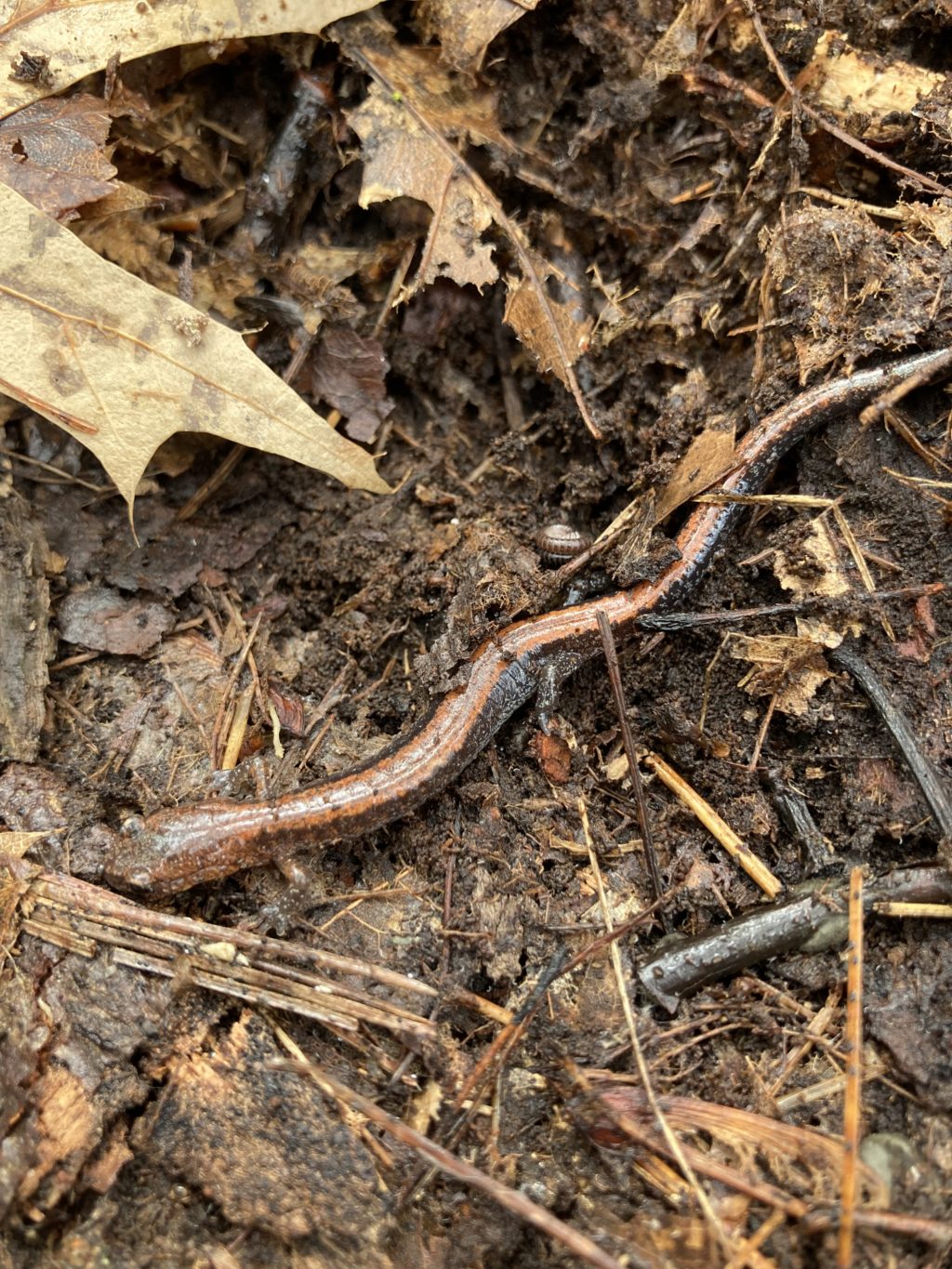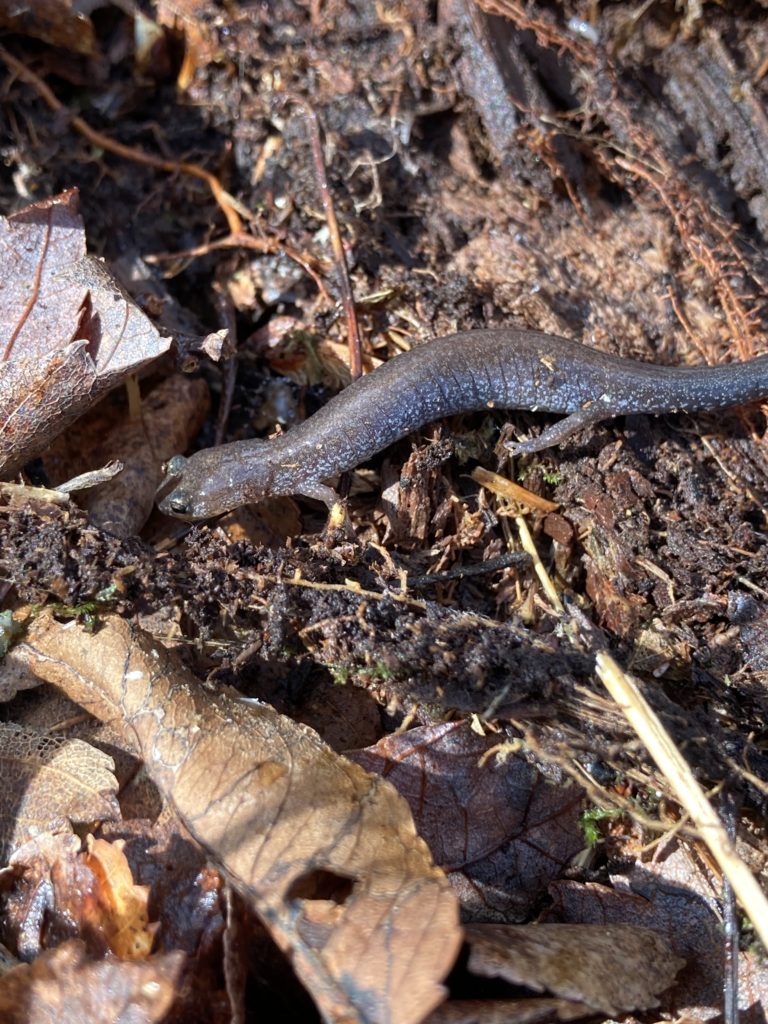Almanac: Invisible Multitude

The amazing red-backed salamander (Plethodon cinereus). Photo: Stephen Braun
You might think that the most abundant vertebrate in this area, a creature so numerous that, in terms of total biomass, this single species would outweigh all of the local bird species combined…you might think you’d notice these creatures. I would think so, anyway. And yet, in my 22 years of roaming the trails of the Pioneer Valley, I had never, until last week, seen a single member of this species.
Now, admittedly, the primary reason I’d never seen these amazingly common creatures is that I’d never looked for them. And I’d never looked for them because I didn’t know they existed. But, in the course of researching the locally-famous yellow-spotted salamander, I learned about the red-backed salamander, which is not only the most common of the 11 species of New England salamanders, but likely the most common local vertebrate, period. A 1975 study at the Hubbard Brook Experimental Forest in New Hampshire found 2,950 salamanders per 2.5 acres, with red-backed salamanders accounting for 93.5% of the total biomass. That means, roughly speaking, you can expect about 1000 of these critters in every wooded acre. The authors of the study concluded that “The biomass of salamanders is about twice that of birds during the bird’s peak breeding season and is about equal to the biomass of small mammals such as mice or shrews.”
Intrigued by this new information, I started poking around for these critters several weeks ago, looking under rocks and logs and leaf litter. But it’s been a fairly cool spring and I repeatedly came up empty. Last weekend, however, it had warmed up enough and was moist enough, that I finally met my first red-backed salamander. Walking along the trails of the Hitchcock Center, I carefully lifted or rolled rotting logs, being careful to replace them as I found them. On my second or third try, I found my quarry…and then many more over the course of the next hour. It was cool enough that these cute little creatures didn’t skitter quickly away but stayed fairly still, looking at me with their small, bright eyes.
Actually, the first little fella I found was not red-backed at all. It was the “lead-backed” variant (or “morph”) of the more common red-backed version. They are the same species, just with an alternate set of the genes coding for skin color, analogous to red-headed humans.

Adult red-backed salamanders are anywhere from 2-5 inches long, with four toes on their dainty little front feet, and five on their back feet. Like some other salamanders, red-backs have no lungs. They don’t breathe. Imagine that…living without ever taking a breath of air. Breathing is so natural and vital to us (and virtually all other terrestrial vertebrates) that it takes an effort to imagine what that would be like.
Red-backs can do without lungs because their skin is so thin that, as long as it’s moist, oxygen can diffuse directly into the salamander’s bloodstream, and carbon dioxide can diffuse out. That caveat “as long as it’s wet,” however, determines most of this animal’s behavior and explains why they are so seldom observed. Since red-backeds will literally suffocate if their skin dries out, they spend most of their lives under leaf litter, rotting logs, rocks, or in tunnels burrowed up to a foot into the ground. Only if it’s raining, or very misty will they travel above ground, looking for small worms, snails, larvae, and the small insects on which they prey.
Unlike many amphibians, and many other salamander species such as the yellow-spotteds, a female red-back does not lay her eggs in water. Instead, she finds a suitably damp, sheltered spot and lays only 6-9 eggs. Also uncommon among amphibians and most salamanders, which typically lay their eggs and leave, red-backed moms remain with their eggs to protect them. She curls herself around her eggs, eating only opportunistically if something should cross her path. Due to the physical effort it requires to produce eggs and guard them without food, female red-backed salamanders only reproduce once every other year. When the eggs hatch, they emerge as tiny, well-formed red-backed salamanders—miniature versions of their parents. They do not undergo any kind of metamorphosis, as do many salamander species. It takes 3-5 years for males to reach sexual maturity, 4-6 years for females, and their average lifespan is estimated to be 8-9 years, although they can live as many as 25 years in captivity.
The most remarkable thing about salamanders is their ability to repair their bodies after injury. Salamanders can regenerate complex structures such as limbs, tails, retinas, and spinal cords, along with some sections of the heart and brain, during any stage of their life cycle. They can also perform scar-free repair of deep tissue wounds after injury. These salamander super powers are the focus of a great deal of current scientific and medical research. It’s too early to tell if we’ll be able to induce human cells to perform the miracles of regeneration that salamanders do automatically, but if we could, how that would transform the lives of amputees and those suffering serious tissue wounds!
Almanac is a regular Indy column of observations, musings, and occasional harangues related to the woods, waters, mountains, and skies of the Pioneer Valley. Please feel free to comment on posts and add your own experiences or observations.

As usual, Steve reminds me of how much I don’t know about the world around me, and how much we need each other, with our various areas of knowledge and passion to create a better world for all creatures, human and otherwise. And how rare it is to find someone who can write so beautifully for the general reader about his knowledge and passion.
Thank you for such kind words Michael…it’s so much fun doing the exploring and poking around, then sharing it with other like-minded souls! Continually humbling… Wish I could do this full-time, but, alas, more prosaic writing is what pays the bills. 🙂
Steve
I just encountered three while puttering about in my yard — including an adorable little 1″ youth — and came back here to refresh my knowledge. Happily, I was refreshed about the “lead-backed” variety, because the first of the three I found was lead-backed.
Great article and writing! Thank you.